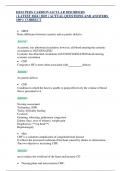Hesi peds cardiovascular - Study guides, Class notes & Summaries
Looking for the best study guides, study notes and summaries about Hesi peds cardiovascular? On this page you'll find 21 study documents about Hesi peds cardiovascular.
All 21 results
Sort by
HESI PEDS CARDIOVASCULAR DISORDERS ( LATEST 2024 / 2025 ) ACTUAL QUESTIONS AND ANSWERS 100% CORRECT
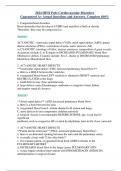
-
2024 HESI Peds Cardiovascular Disorders Guaranteed A+ Actual Questions and Answers, Complete 100%
- Exam (elaborations) • 9 pages • 2024
-
Available in package deal
-
- $13.99
- + learn more
2024 HESI Peds Cardiovascular Disorders Guaranteed A+ Actual Questions and Answers, Complete 100% 1. Congenital heart disorders Heart anomalies that develop in UTERO and manifest at birth or shortly Thereafter -they may be categorized as: Answer: ACYANOTIC: ventricular septal defect (VSD), atrial septal defect (ASD), patent ductus arteriosus (PDA), coarctation of aorta, aortic stenosis (AS) or CYANOTIC: tetrology of fallot, truncus arteriosus, tranposition of great vessels: Acyantotic...
2024 HESI Peds Cardiovascular Disorders V1 - V3 | Guaranteed A+ Actual Questions and Answers, Complete 100%
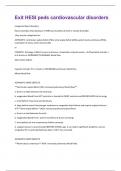
-
Exit HESI peds cardiovascular disorders question with complete solution graded A+
- Exam (elaborations) • 9 pages • 2023
-
- $4.49
- + learn more
Congenital heart disorders Heart anomalies that develop in UTERO and manifest at birth or shortly thereafter -they may be categorized as: ACYANOTIC: ventricular septal defect (VSD), atrial septal defect (ASD), patent ductus arteriosus (PDA), coarctation of aorta, aortic stenosis (AS) or CYANOTIC: tetrology of fallot, truncus arteriosus, tranposition of great vessels - Acyantotic include: L to R shunts or INCREASED PULMONARY blood flow Obstructive defects Cyanotic include: R to L shunts ...
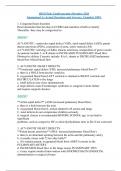
-
HESI Peds Cardiovascular Disorders 2023 Guaranteed A+ Actual Questions and Answers, Complete 100%
- Exam (elaborations) • 9 pages • 2023
- Available in package deal
-
- $11.99
- + learn more
HESI Peds Cardiovascular Disorders 2023 Guaranteed A+ Actual Questions and Answers, Complete 100% 1. Congenital heart disorders Heart anomalies that develop in UTERO and manifest at birth or shortly Thereafter -they may be categorized as: Answer: ACYANOTIC: ventricular septal defect (VSD), atrial septal defect (ASD), patent ductus arteriosus (PDA), coarctation of aorta, aortic stenosis (AS) or CYANOTIC: tetrology of fallot, truncus arteriosus, tranposition of great vessels: Acyantotic ...

-
2023 HESI Cardiovascular Disorders BUNDLE Test | Test Bank, Hesi Pediatric, V1,V2,V3,V4,V5,V6,V7 | Brand New! Graded A++ All Q&As Included!!
- Package deal • 7 items • 2023
-
- $35.49
- + learn more
2023 HESI Cardiovascular Disorders BUNDLE Test | Test Bank, Hesi Pediatric, V1,V2,V3,V4,V5,V6,V7 | Brand New! Graded A++ All Q&As Included!! HESI Peds Cardiovascular Disorders 2023 HESI Pediatric Cardiovascular HESI Cardiovascular 2023 Cardiovascular Disorders HESI Exam
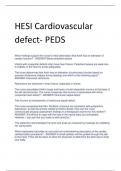
-
HESI Cardiovascular defect- PEDS questions 100% and correct answers2023.2024
- Exam (elaborations) • 5 pages • 2023
-
- $9.99
- + learn more
HESI Cardiovascular defect- PEDS Which findings support the nurse's initial observation that Keith has an alteration of cardiac function? - ANSWER Weak peripheral pulses Infants with congenital defects often have heart failure. Peripheral pulses are weak due to inability of the heart to pump adequately. The nurse determines that Keith has an alteration of pulmonary function based on exercise intolerance (fatigue during feeding) and which of the following signs? - ANSWER Intercostal ...
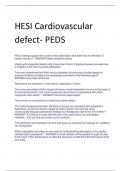
-
2024 HESI Cardiovascular defect- PEDS
- Exam (elaborations) • 5 pages • 2024
-
- $11.49
- + learn more
Which findings support the nurse's initial observation that Keith has an alteration of cardiac function? - ANSWER Weak peripheral pulses Infants with congenital defects often have heart failure. Peripheral pulses are weak due to inability of the heart to pump adequately. The nurse determines that Keith has an alteration of pulmonary function based on exercise intolerance (fatigue during feeding) and which of the following signs? - ANSWER Intercostal retractions Retractions are observed i...
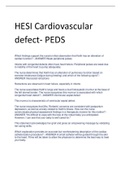
-
Exam (elaborations) HESI Cardiovascular defect- PEDS
- Exam (elaborations) • 5 pages • 2023
-
- $7.99
- + learn more
Which findings support the nurse's initial observation that Keith has an alteration of cardiac function? - ANSWER Weak peripheral pulses Infants with congenital defects often have heart failure. Peripheral pulses are weak due to inability of the heart to pump adequately. The nurse determines that Keith has an alteration of pulmonary function based on exercise intolerance (fatigue during feeding) and which of the following signs? - ANSWER Intercostal retractions Retractions are observe...
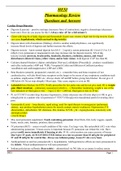
-
HESI Pharmacology Review Questions and Answers
- Exam (elaborations) • 16 pages • 2023
-
- $10.49
- 1x sold
- + learn more
HESI Pharmacology Review Questions and Answers Cardiac Drugs/Diuretics • Digoxin (Lanoxin) – positive inotrope (increases force of contraction); negative chronotrope (decreases heart rate). How do you assess for this? (Always take AP for a full minute!) • Client with long hx of daily digoxin and furosemide (Lasix) use; creates a high risk for dig toxicity (Lasix can cause hypokalemia, which can lead to dig toxicity) • Digoxin taken with dronedarone (Multaq), which is another antid...

Did you know that on average a seller on Stuvia earns $82 per month selling study resources? Hmm, hint, hint. Discover all about earning on Stuvia

